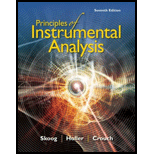
(a)
Interpretation:
At higher temperature rate, transition of atoms of sodium occurs from 4s to 3p state and the average wavelength of sodium due to the emission is 1139 nm. Ratio of excited state 4 seconds to ground state 3seconds needs to be calculated for acetylene- oxygen flame of 3000oC.
Concept introduction:
Calculation of ratio is done by using the Boltzmann equation, given as-
Where,
Nj = no. of ions in excited state
No = no. of ions in ground state
Ej = energy difference of excited state and ground state
gj = statistical weight for excited state
go = statistical weight for ground state
k= Boltzmann constant
T = absolute temperature
Energy of atom is calculated by the following formula-
Where,
h= Planck’s constant
c = light velocity
λ= wavelength
Ej= energy difference
(b)
Interpretation:
Ratio of excited state 4s to ground state 3s needs to be calculated for an inductively coupled plasma source of 9000oC.
Concept introduction:
Calculation will be done using the following formulas-
And
Want to see the full answer?
Check out a sample textbook solution
Chapter 9 Solutions
Principles of Instrumental Analysis
- What is the final product when D-galactose reacts with hydroxylamine?arrow_forwardIndicate the formula of the product obtained by reacting methyl 5-chloro-5-oxopentanoate with 1 mole of 4-penten-1-ylmagnesium bromide.arrow_forwardIn the two chair conformations of glucose, the most stable is the one with all the OH groups in the equatorial position. Is this correct?arrow_forward
- please help me with my homeworkarrow_forwardhelparrow_forwardThe temperature on a sample of pure X held at 1.25 atm and -54. °C is increased until the sample boils. The temperature is then held constant and the pressure is decreased by 0.42 atm. On the phase diagram below draw a path that shows this set of changes. pressure (atm) 2 0 0 200 400 temperature (K) Xarrow_forward
- QUESTION: Answer Question 5: 'Calculating standard error of regression' STEP 1 by filling in all the empty green boxes *The values are all provided in the photo attached*arrow_forwardpressure (atm) 3 The pressure on a sample of pure X held at 47. °C and 0.88 atm is increased until the sample condenses. The pressure is then held constant and the temperature is decreased by 82. °C. On the phase diagram below draw a path that shows this set of changes. 0 0 200 temperature (K) 400 аarrow_forwarder your payment details | bar xb Home | bartleby x + aleksogi/x/isl.exe/1o u-lgNskr7j8P3jH-1Qs_pBanHhviTCeeBZbufuBYT0Hz7m7D3ZcW81NC1d8Kzb4srFik1OUFhKMUXzhGpw7k1 O States of Matter Sketching a described thermodynamic change on a phase diagram 0/5 The pressure on a sample of pure X held at 47. °C and 0.88 atm is increased until the sample condenses. The pressure is then held constant and the temperature is decreased by 82. °C. On the phase diagram below draw a path that shows this set of changes. pressure (atm) 1 3- 0- 0 200 Explanation Check temperature (K) 400 X Q Search L G 2025 McGraw Hill LLC. All Rights Reserved Terms of Use Privacy Cearrow_forward
 Principles of Instrumental AnalysisChemistryISBN:9781305577213Author:Douglas A. Skoog, F. James Holler, Stanley R. CrouchPublisher:Cengage Learning
Principles of Instrumental AnalysisChemistryISBN:9781305577213Author:Douglas A. Skoog, F. James Holler, Stanley R. CrouchPublisher:Cengage Learning

